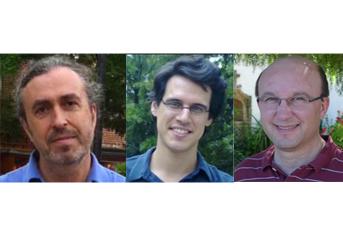Associação Portuguesa de Investigação em Cancro
Evolutionary Game Theory of Cancer
Evolutionary Game Theory of Cancer

A acumulação de mutações somáticas a que o genoma celular está permanentemente exposto muitas vezes conduz ao aparecimento de um cancro. A análise de um tumor qualquer revela a presença, para além das células malignas, de outras células de 'apoio', como sejam os fibroblastos, células do sistema imunológico de vários tipos e até mesmo vasos sanguíneos. Em conjunto, estas células criam o micro-ambiente que permite que a população de células malignas cresça a ponto de induzir a manifestação da doença. Deste modo, a compreensão da dinâmica de crescimento do tumor bem como da sua resposta a uma terapêutica requer que as interações entre as células malignas e as células normais sejam investigadas no ambiente em que elas acontecem. As interações complexas entre células num eco-sistema como este resultam da troca de informações na forma de citocinas e interações dependentes de processos de aderência.
Tais processos impõem custos e benefícios às células participantes que podem ser convenientemente contabilizados na forma de uma matriz de pay-off de um jogo. Como resultado, a progressão do tumor e dinâmica correspondente podem ser estudados em termos da teoria evolutiva de jogos (EGT), a qual proporciona uma estrutura conveniente para capturar a natureza dinâmica do eco-sistema tendo em conta a frequência relativa das células intervenientes.
Neste trabalho começamos por oferecer uma revisão tutorial dos aspectos centrais da EGT, estabelecendo uma relação com o problema do cancro. De seguida, mostramos como aplicar a EGT ao estudo de diferentes manifestações e da dinâmica do mieloma múltiplo. Para esse efeito, traduzimos sinais bioquímicos complexos em custos e benefícios de diferentes tipos de células, definindo assim uma matriz pay-off do jogo. Em seguida, utilizamos as propriedades conhecidas das equações de EGT para reduzir o número de parâmetros que caracterizam a evolução da doença. Por fim, apresentamos uma interpretação desses parâmetros fundamentais em termos da sua função concreta no ecossistema que estamos a descrever, por forma a estabelecer previsões sobre o tipo e o tempo característico de intervenções que podem alterar a história natural do mieloma múltiplo.
Autores e Afiliações:
Jorge M. Pacheco- Centro de Biologia Molecular e Ambiental & Departamento de Matemática e Aplicações, Universidade do Minho, Braga 4710-057, Portugal; ATP-Group, CMAF, Instituto para a Investigação Interdisciplinar, Lisboa 1649-003, Portugal
Francisco C. Santos - INESC-ID & Instituto Superior Técnico, Universidade de Lisboa, Taguspark, Porto Salvo, Lisboa 2744-016, Portugal; ATP-Group, CMAF, Instituto para a Investigação Interdisciplinar, Lisboa 1649-003, Portugal
David Dingli- Division of Hematology and Department of Molecular Medicine, Mayo Clinic, 200 First Street SW, Rochester, MN 55905, USA
Abstract:
The accumulation of somatic mutations, to which the cellular genome is permanently exposed, often leads to cancer. Analysis of any tumour shows that, besides the malignant cells, one finds other ‘supporting’ cells such as fibroblasts, immune cells of various types and even blood vessels. Together, these cells generate the microenvironment that enables the malignant cell population to grow and ultimately lead to disease. Therefore, understanding the dynamics of tumour growth and response to therapy is incomplete unless the interactions between the malignant cells and normal cells are investigated in the environment in which they take place. The complex interactions between cells in such an ecosystem result from the exchange of information in the form of cytokines- and adhesion-dependent interactions. Such processes impose costs and benefits to the participating cells that may be conveniently recast in the form of a game pay-off matrix. As a result, tumour progression and dynamics can be described in terms of evolutionary game theory (EGT), which provides a convenient framework in which to capture the frequency-dependent nature of ecosystem dynamics. Here, we provide a tutorial review of the central aspects of EGT, establishing a relation with the problem of cancer. Along the way, we also digress on fitness and of ways to compute it. Subsequently, we show how EGT can be applied to the study of the various manifestations and dynamics of multiple myeloma bone disease and its preceding condition known as monoclonal gammopathy of undetermined significance. We translate the complex biochemical signals into costs and benefits of different cell types, thus defining a game pay-off matrix. Then we use the well-known properties of the EGT equations to reduce the number of core parameters that characterize disease evolution. Finally, we provide an interpretation of these core parameters in terms of what their function is in the ecosystem we are describing and generate predictions on the type and timing of interventions that can alter the natural history of these two conditions.
Revista: Interface Focus
Link: http://rsfs.royalsocietypublishing.org/content/4/4/20140019




